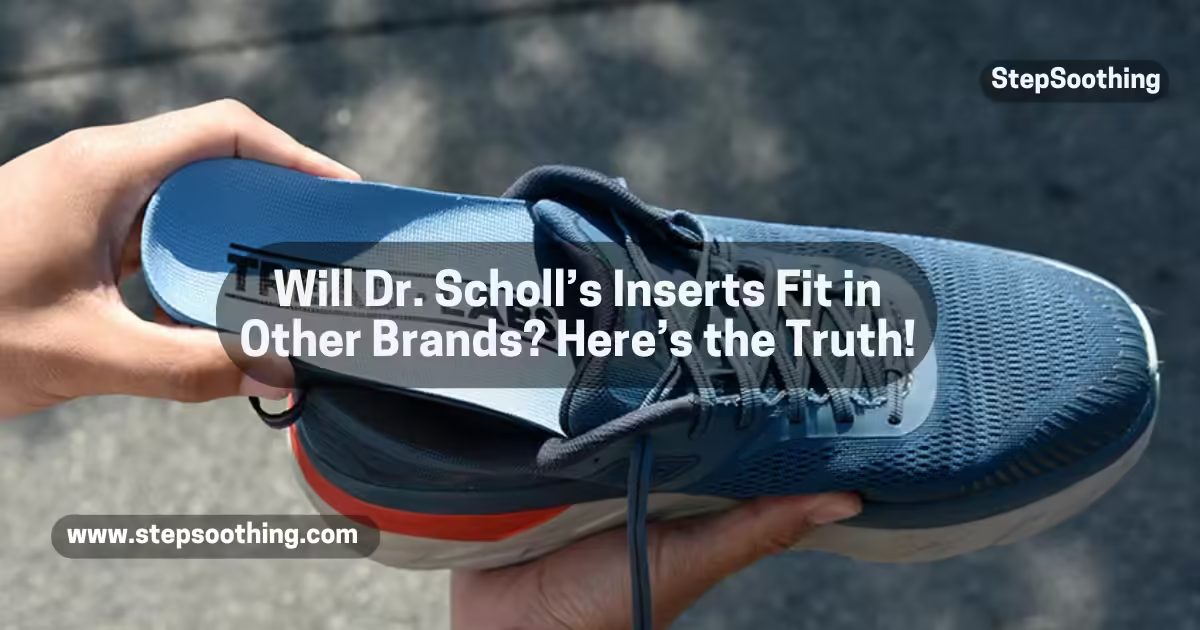Wondering if your favorite Dr. Scholl’s inserts can make a comfy crossover into different shoe brands? You’re not alone. Many people rely on these inserts to alleviate foot pain and add much-needed support, but things can get tricky when pairing them with shoes from other brands. Fit, comfort, and support—three factors we all prioritize—might be compromised, or maybe even enhanced, when trying to fit Dr. Scholl’s inserts in shoes that weren’t designed with them in mind. In this guide, we’ll break down everything you need to know, from the best types of shoes for your inserts to real-life insights from users who’ve tested Dr. Scholl’s with different brands. Ready to take your foot comfort to the next level? Let’s dive in!
How to Adjust Inserts for the Best Fit Across Different Shoes

Understanding Dr. Scholl’s Inserts and How They Work
Dr. Scholl’s inserts have become popular for a reason: they provide targeted comfort, support, and relief from common foot pain caused by standing, walking, or even light exercise. Made to address issues like arch discomfort, heel pressure, and overall foot fatigue, Dr. Scholl’s offers a variety of options to meet different foot health needs. Their line of inserts includes full-length insoles, heel cups, arch supports, and more specialized products tailored to unique foot types or pain points.
Each type of insert is designed with specific foot support in mind. For instance, full-length insoles can help relieve tension along the entire foot, while heel inserts are crafted to provide cushioning specifically to the heel area. With a focus on comfort and durability, these inserts can make a substantial difference for individuals who are on their feet often, suffer from foot discomfort, or need extra cushioning and alignment. But with such a unique design and intended use, the question remains: can Dr. Scholl’s inserts be successfully paired with other shoe brands?
Can Dr. Scholl’s Inserts Really Fit in Other Shoe Brands?
The answer is not straightforward since several factors impact how well Dr. Scholl’s inserts will fit in non-Dr. Scholl’s shoes. The adaptability of these inserts largely depends on the shoe’s structure, shape, and even material. Many users find that these inserts work well across different shoe brands, ranging from popular athletic shoes like Nike and Adidas to more formal options like Clarks or Cole Haan. However, some shoes may fit less comfortably with an insert, particularly if they are narrow, have limited toe space, or are not designed with removable insoles.
Some common concerns include:
- Fit: Many worry that adding an insert will change the original fit of their shoe, possibly making it tighter or too snug.
- Comfort: Users often question if the insert will remain secure, as slipping can occur if the insert isn’t a good match for the shoe.
- Support: Another concern is whether the insert will interfere with or enhance the shoe’s existing support features.
Though these concerns are valid, finding the right match with Dr. Scholl’s inserts can lead to improved comfort, reduced pain, and benefits of using insoles for foot health overall.

Factors to Consider When Using Dr. Scholl’s in Different Shoe Brands
Choosing the right type of Dr. Scholl’s insert involves more than just finding the correct size. Different factors impact how an insert will function in various brands of shoes, and understanding these factors can make the difference between comfort and frustration.
Shoe Type (Casual, Athletic, Formal, Work):
Inserts work differently in various types of shoes. Athletic shoes, for instance, often have more space to accommodate inserts without causing discomfort, whereas formal shoes tend to be narrower and might not work as well with thicker inserts. Work shoes may have their own cushioning, but Dr. Scholl’s inserts can still provide additional comfort, especially for those who work long shifts.
Fit and Size Adjustments:
Dr. Scholl’s inserts come in several sizes, so choosing one that fits snugly without leaving gaps is essential. While many inserts are labeled as one-size-fits-most, trimming options are available for a custom fit. For those with narrow shoes, trimming may be essential to prevent crowding in the toe box or heel area.
Insole Removal Options:
Shoes with removable insoles can generally work better with Dr. Scholl’s inserts, as taking out the original insole frees up space, allowing the insert to fit comfortably. Without this option, adding an insert might make the shoe too tight or uncomfortable, especially if it was already a snug fit.

Tips for Achieving the Best Fit in Any Shoe Brand
While it can be challenging to find a perfect fit, several tips can help maximize comfort and effectiveness when using Dr. Scholl’s inserts with other shoe brands.
Choosing the Right Type of Insert:
Dr. Scholl’s offers various inserts, each tailored for specific needs. When selecting one, consider the shoe type, your foot shape, and any pain points. Full-length insoles work well in athletic and casual shoes, while heel cups and cushioned insoles or half-length inserts can provide cushioning in tighter, more formal footwear.
Making Small Adjustments to Maximize Comfort:
Minor adjustments can go a long way in achieving a better fit. If an insert feels too large, trimming the edges can help; if it moves around in the shoe, adding a small piece of double-sided tape can prevent slipping. Another option is to pair inserts with heel grips or adhesive pads to increase comfort without sacrificing space.
Testing for the Perfect Fit:
Don’t be afraid to try the inserts in several pairs of shoes. Testing them across multiple brands and styles can help you understand which shoes work best with the inserts and where adjustments might be needed. Walking around indoors before committing to wearing them outside can also help identify any fit or comfort issues before they become a problem.

Real-Life Experiences: What Users Say About Dr. Scholl’s Inserts in Other Brands
Many individuals have shared positive experiences with using Dr. Scholl’s inserts in various shoe brands. Here are some insights gathered from actual users:
- Success Stories:
One user found that using Dr. Scholl’s inserts in their Adidas running shoes reduced heel pain during long-distance runs, saying that the support was “exactly what was needed” to make their workouts more comfortable. Another user found that the inserts helped maintain comfort during long work shifts when used in a pair of Clarks work shoes. - Challenges Encountered:
Not everyone has the same experience, of course. A few users reported that certain Dr. Scholl’s inserts made their formal shoes feel too tight, while others found that the insert shifted around in sandals. This demonstrates the importance of choosing the correct insert for the shoe style and taking the time to experiment before committing to regular use. - Insights from Customer Reviews:
Customer reviews reveal that Dr. Scholl’s inserts work especially well in athletic and casual footwear but may be less effective in sandals, narrow dress shoes, or other styles with limited room. However, users often praise the inserts for offering lasting relief from foot pain, even when switching between multiple shoe brands.

Expert Advice: Making Dr. Scholl’s Inserts Work for You
Experts, including podiatrists and foot health specialists, offer some valuable advice on maximizing the benefits of Dr. Scholl’s inserts, regardless of the shoe brand.
Consulting with a Foot Specialist or Podiatrist:
If foot pain is persistent, consulting with a foot specialist can help you determine if Dr. Scholl’s inserts—or even custom orthotics—are the right option. A professional can recommend a specific type of insert, helping you avoid purchasing products that won’t offer sufficient support for your needs.
Choosing the Right Inserts Based on Foot Shape and Shoe Style:
An expert tip is to match inserts not only to your foot shape but also to the shoe’s intended use. For example, runners with high arches may benefit from inserts with extra arch support insoles, while those using work boots may want inserts designed for heel cushioning.
Regularly Evaluating Insert Effectiveness:
Over time, even high-quality inserts can lose effectiveness. Regularly checking for signs of wear, such as loss of cushioning or noticeable flattening, can help you determine how long do insoles last when it’s time to replace your inserts to maintain comfort and support.
Final Thoughts: Finding the Perfect Balance of Comfort and Fit
Dr. Scholl’s inserts have gained popularity for their adaptability, pain relief, and ability to support foot health across a range of shoe brands. While some trial and error may be necessary to find the perfect fit, the effort is often worth it for the improved comfort and reduced pain they can provide. Take the time to explore different combinations, choose the right insert for each shoe type, and pay attention to your feet’s needs. Ultimately, finding the right balance between comfort and fit can make a world of difference in your everyday comfort and foot health.
You May Also Like
Do you put Dr Scholls on top of Insoles
Dr Scholls Custom Fit number Meaning
People Also Asked
Can Dr. Scholl’s Inserts Be Moved Between Different Shoes?
Yes, Dr. Scholl’s inserts are often designed for flexibility, allowing them to be moved between shoes. However, the insert’s lifespan may be shortened with frequent transfers, and fit may vary based on the shoe style.
Will Dr. Scholl’s Inserts Work in High Heels or Flats?
Some inserts may fit in heels or flats, but it’s best to use specific Dr. Scholl’s products designed for these shoe types, as traditional full-length inserts may not provide the right fit.
How Often Should I Replace Dr. Scholl’s Inserts?
The general recommendation is to replace inserts every six months or sooner if there are visible signs of wear, as worn inserts can lose effectiveness.
Is There a “Break-In” Period for Dr. Scholl’s Inserts?
While most inserts don’t require an extensive break-in period, some users may need a few days to adjust to the additional support or cushioning.
Can I Use Dr. Scholl’s Inserts in Shoes with Non-Removable Insoles?
Yes, but keep in mind that inserts added on top of non-removable insoles may cause tightness. It’s best to experiment with different insert sizes or use half-length options.



